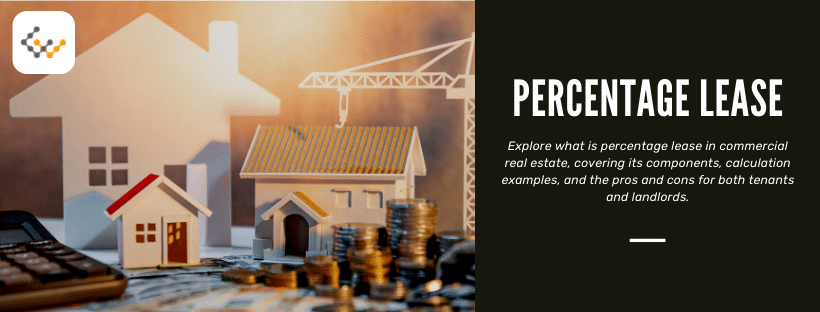Percentage Lease: What It Is and How it Works in Commercial Real Estate?

There are several different ways to structure a commercial real estate lease. When leasing retail spaces, a percentage lease is one of the common options. The lease’s structure can have benefits for both the lessor and lessee.
What is Percentage Lease and How Does It Work?
A percentage lease is a commercial real estate lease wherein the tenant pays the landlord a portion of their sales. The percent of sales paid is assessed above a break-even point, and in addition to a base rent.
The lease structure makes both parties invested in the tenant’s success, as both tenant and landlord make more when sales increase. Tenants may enter into it for a reduced base rent.
In short, the lease agreement lets tenants pay more in good months and less in bad months. In exchange, landlords get the opportunity to benefit from increased sales.
What Type of Tenant Uses a Percentage Lease Most Often?
The percentage lease structure is almost exclusively used in retail settings, where variable sales create challenges and opportunities for each party.
A reduced base rent makes it easier for retail tenants to survive slower sales months, and helps ensure tenants can pay their rent during these months. It also creates the potential for higher rents during high-sales months, and overall higher rents if the tenant’s business is successful.
Landlords and tenants leasing shopping centers, traditional malls, strip malls, and even standalone retail buildings might use a percentage lease. It’s fairly common practice for department stores, specialty retailers, restaurants, and even activity centers in retail spaces (e.g. arcades, indoor ropes courses, escape rooms, etc.).
Main Components of a Percentage Lease
A percentage lease is composed of more than just the sales percent. It has three main components:
- Base Rent: The amount paid each month regardless of sales. This is essentially a normal rent payment, although it’s less than would otherwise be charged for rent. Base rent is usually calculated on a per-square-foot basis.
- Breakpoint: The point at which the percent of sales payment begins. No percentage of sales is paid on sales below the breakpoint, but the percentage is paid on all sales above this amount. The breakpoint depends on a business’s expected sales and lease. This is also called a break-even point.
- Percentage Rate: The percent that’s paid on all sales above the breakpoint. The percentage is usually relatively low but not insignificant. The exact amounts depend on the lease. The percentage is usually taken from gross sales.
How Do You Calculate a Percentage Lease?
Calculating a percentage lease is a simple but multi-step process. The gross sales exceeding the breakpoint must be determined, and then the percentage rate applied to this to determine the additional rent due. This amount is added to the base rent.
Rent Payment = ((Gross Sales – Breakpoint) x Percentage Rate) + Base Rent
Like most commercial leases, the rent is normally calculated and paid monthly.
Example of Percentage Lease Calculation
For example, assume a specialty retailer leases 2,500 square feet at a rate of $4 per square foot for a base rent of $10,000. Their breakpoint is $100,000, and they have a percentage rate of 6%. This is a highly seasonal business.
During slower months, the retailer sees sales ranging from $60,000 to $90,000. They’d only pay $10,000 each of these months since their sales don’t reach the breakpoint.
Working up to their busy season, the retailer might see gross sales of around $120,000. In a month, with these sales, the total rent paid would be $11,200. The percentage paid would be $1,200, based on 6% of $20,000 in sales above the breakpoint. This is added to the base rent of $10,000.
During the best months, the retailer might have gross sales of $160,000. In such a month, the total rent paid would be $13,600. That’s a percentage payment of 6% based on $60,000 in excess sales, and it’s added onto the base rent of $10,000.
This arrangement would help the retailer survive their slower months, such as January and February, when sales might just cover operating costs. The moderate months might work out to a relatively comparable market rate, and they can cover the higher rent payments during the busy holiday season. Both retailers and landlords are invested in having a strong holiday season.
Pros and Cons of Percentage Lease for Tenants and Landlords
In a retail setting, the percentage lease structure can have substantial benefits for both tenants and landlords. There are also a few drawbacks that should be noted, however.
For Tenants
Tenants benefit from rents that better align with their sales, but might profit less in the best months.
Pros
- Cash Flow: Monthly cash flow is easier to manage since rent corresponds to sales. Specifically, lower rents during slower seasons make lean months easier to manage.
- Low Base Rent: Base rents are typically lower than what the market would otherwise sustain.
- Aligned Interests: Both tenant and landlord are invested in the tenant’s success. This can make landlords more willing to give a preferable location and maintain the property in order to increase foot traffic. The landlord may also be more willing to increase signage.
Cons
- Monthly Accounting: Tenants must keep accurate books, particularly with regard to sales. While this is a best practice anyway, it’s absolutely essential with the lease structure.
- Higher Total Rent: The total rent paid over the course of a year may actually be higher than what the market would sustain, especially if sales are better than expected.
- Decreased Profits: Paying a percent of sales decreases the net profit during good sales months. The decrease might be particularly noticeable if distributions, increased labor costs, or other expenses also need to be paid in these months.
For Landlords
Landlords give up some guaranteed rent in order to gain upside if the tenant does well.
Pros
- Rent Potential: A tenant’s success can yield higher rents than the market would sustain, as rent goes up with high sales.
- Cash Flow: Higher cash flow in some months may make managing repairs or major maintenance easier. These tasks can be scheduled for months following rent spikes.
Cons
- Lower Rent: The base rent is often below market rates, and could yield decreased rent if a tenant isn’t successful.
- Income Variability: Rent income fluctuates with the tenant’s sales, leading to less predictability. This can be mitigated by ensuring the base rent still covers operating expenses.
- Accounting Audits: The tenant’s sales reporting must be checked and verified each month.
Wrapping Up
A percentage lease can be a mutually beneficial way to structure retail leases. If you have a retail space or are moving into one, consider how this type of lease might benefit you (and also the other party).

